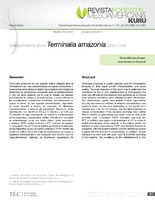Mostrar el registro sencillo del ítem
Establecimiento in vitro de Terminalia amazonia (Gmel.) Excell
| dc.contributor.author | Méndez-Álvarez, Dawa | |
| dc.contributor.author | Abdelnour-Esquivel, Ana | |
| dc.date.accessioned | 2017-05-19T16:23:58Z | |
| dc.date.available | 2017-05-19T16:23:58Z | |
| dc.date.issued | 2014 | |
| dc.identifier | https://dx.doi.org/10.18845/rfmk.v11i27.1774 | |
| dc.identifier.citation | https://revistas.tec.ac.cr/index.php/kuru/article/view/1774 | es |
| dc.identifier.issn | 2215-2504 | |
| dc.identifier.uri | https://hdl.handle.net/2238/7098 | |
| dc.description.abstract | Terminalia amazonia es una especie nativa utilizada para la reforestación por sus características de rápido crecimiento y madera de buena calidad. El objetivo principal de este trabajo fue determinar la condiciones necesarias para el establecimiento in vitro de dicha especie, por lo cual se trabajó con plantas provenientes de campo y de invernadero, a estas últimas se les establecieron condiciones sanitarias, posteriormente se evaluó el efecto de dos agentes desinfectantes, hipoclorito de sodio (NaClO) y cloruro de mercurio, en diferentes concentraciones y tiempos de exposición. Siendo la doble desinfección con NaClO al 3% por 5 minutos y al 1,5% por 10 minutos, el mejor tratamiento en reducir la contaminación de los explantes y mantenerlos viables. Se utilizaron una serie de antioxidantes, como son ácido cítrico, ácido ascórbico, L-cisteína, PVPP, carbón activado y DTT, además de emplear un tratamiento frío a 4°C con el objetivo de inhibir la fenolización de los explantes. El uso de carbón activado y PVPP dentro del medio de cultivo fueron los mejores tratamientos en cuanto a explantes sobrevivientes y con oxidación leve (53,3% y 66,7% respectivamente). Además, se emplearon reguladores de crecimiento como BAP y KIN para promover la brotación en los explantes. Las condiciones para el establecimiento in vitro dependen directamente de la especie con que se trabaje. | es |
| dc.description.abstract | Terminalia amazonia is a native species used for reforestation because of their rapid growth characteristics and wood quality. The main objective of this study was to determine the conditions for the in vitro establishment of that species, the work was with plants from field and from greenhouse, to the last ones sanitary conditions were established prior disinfection. Two disinfectants agents were tested: sodium hypochlorite (NaClO) and mercuric chloride at different concentrations and exposure times. As the dual disinfection of 3% NaClO for 5 minutes and 1,5% for 10 minutes, was the best treatment to reduce contamination of the explants and keep them viable. Also a number of antioxidants was used, such as citric acid, ascorbic acid, L-cysteine, PVPP, activated charcoal and DTT, in addition was used a cold treatment at 4°C in order to inhibit phenolization of the explants. In the culture media, the addition of active charcoal and PVPP were the best treatments evaluated, with the lowest oxidation and the highest survival of explants (53,3% and 66,7% respectively). In addition, growth regulators as BAP and KIN were used to promote sprouting in the explants. The conditions for the establishment in vitro dependent directly on the species with which they work. | |
| dc.language.iso | spa | es |
| dc.source | Revista Forestal Mesoamericana Kurú. Volumen 11, n°27. Julio, 2014 | |
| dc.subject | Terminalia amazonia | es |
| dc.subject | Micropropagación | es |
| dc.subject | Oxidación | es |
| dc.subject | In vitro | es |
| dc.subject | Desinfección | es |
| dc.subject | Research Subject Categories::NATURAL SCIENCES::Biology::Cell and molecular biology::Cell biology | es |
| dc.subject | Condiciones sanitarias | |
| dc.subject | Micropropagation | |
| dc.subject | Oxidation | |
| dc.subject | Disinfection | |
| dc.subject | Sanitary conditions | |
| dc.subject | Antioxidantes | |
| dc.subject | Antioxidants | |
| dc.title | Establecimiento in vitro de Terminalia amazonia (Gmel.) Excell | es |
| dc.type | info:eu-repo/semantics/article | es |
Ficheros en el ítem
Este ítem aparece en la(s) siguiente(s) colección(ones)
-
Artículos [39]


